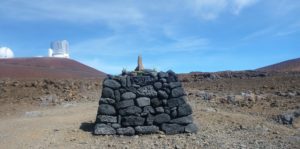Mauna Kea Matters: An Experiment in Public Engagement
By Greg Johnson

Mauna Kea matters. Of this much, I’m very sure. But just how it matters, and to whom, is for me an open question and something I am trying to understand. The dispute currently unfolding in Hawai`i absolutely matters to many Native Hawaiians, if in a range of ways. It also matters to some scholars of religion, a number of whom have visited the mauna in the past few years. Frankly, it is the kind of cultural moment that should matter to scholars of religion generally and should be more widely discussed, theorized, and taught. The intersection of sacred and environmental claims, state (mis)management of the same, and direct protest as religious conduct deserves our attention and engagement. Most of all, it should and can matter to our publics. But how do we gain traction here? As one step in this direction, this brief blog and the essay I hope comes out of it are a wager about trying to reach two very different audiences with the same piece in a way that might result in concrete engagement.
In an effort to get right to the point of this exercise, I refrain from setting up the context of the Mauna Kea-TMT dispute here. Instead, I urge you to look at the Pu`uhonua o Pu`uhuluhulu website and Facebook page, a recent set of essays by leading Native Hawaiian and ally scholars published by Radical History Review found here: “Mauna Kea—The Abusable Past”, and an article by Religion News Service reporter, Jack Jenkins. For basic orientation, two facts are important to grasp: (1) four and a half months after the protest began, the protectors (kia`i) still have control of the Mauna Kea road and (2) they conduct full ritual protocol on the road three times a day every day, led by the most influential practitioner families in Hawai`i.
My goal is to strike up a back-and-forth between the two groups of people I spend most of my time with but who don’t know each other very well: scholars of religion and Native Hawaiians involved in the protection of Mauna Kea. If this conversation succeeds initially, I’ll then draw in a person uniquely qualified to address the issue from both sides, Marie Alohalani Brown, a professor of religious studies at University of Hawai`i Manoa, an arrestee during the protests, and a stalwart of the movement. Alohalani has agreed to co-write an essay with me in response to the posts we hope this blog generates.
My hope for the conversation I am imagining stands for many possible conversations of a similar kind where scholars and the people we concern ourselves with actually talk to rather than past one another. It is provoked by two very recent experiences: the first is that I have just returned from Mauna Kea on my fourth trip in five months, this time with a fellow scholar of religion and collaborator, Sally Promey, and we left inspired to share a sense of what is happening; second, even more recently, I have returned from the annual meeting of the American Academy of Religion where the theme of public engagement was admirably front-and-center, at least as a stated aspiration. As my Hawaiian friends would say: K den, try.
As soon as this piece is published, I will tag various friends on Facebook on both sides to try to prompt readership and engagement. Why Facebook? It is old-fashioned, problematic, and possibly (hopefully?) on its way out, but it is still used by both groups that I wish to reach here. Furthermore, Pua Case, a leader of the Mauna Kea movement, calls it Sacred Facebook, so by virtue of that claim alone it should hold immediate interest, for hers is a story about global media, Indigenous traditions in real time, and an invitation for engagement.
As for the friends I’m going to tag, they don’t know I’m doing so. They might welcome the opportunity to engage, miss it entirely, or get cranky with me for invoking their names. I’m not too worried about blowback of this sort—it is the risk we all take by being on social media. But I have some good reasons to be optimistic. All of the people I will tag engage important issues of relevance on Facebook on a regular basis and they are all actual friends in that alternative sphere known as “real life.” So, friends, bear with me.
I hope certain questions get addressed in response to my post. What does each group have to say to the other? What is the story each group would tell the other about themselves? And how might we facilitate and model engagement in a way that opens up the conversation to an interested public? If the conversation I aspire to initiate has any legs at all, I hope various people will chime in from their perspectives to say why their views matter, what they care about, what they are doing about it, and what they are prepared to do.
Where do I stand? I have my own opinions of course, which are informed by a close study of the legal process, ethnographic research, and my connections to the community. My position is the following: Mauna Kea matters as a site of deep and sustained expression of Hawaiian religion-in-action; proper consultation concerning Hawaiian traditional and customary rights did not happen; Native Hawaiian traditions and rights have thereby not been adequately recognized or honored; and the state constitution, not to mention the legacy of the Hawaiian Kingdom, has been dishonored in the process. But my perspective is not what matters here. I am pushing to understand better how issues of consequence become visible to various publics and how scholars of religion might facilitate this process. The issue is not whether we support the movement (some of us do and will), but how we might learn from it and, perhaps, how people in the movement and publics watching it unfold might learn from us.
At the bare minimum, the fact that scholars of religion should attend to the movement says something about its religious qualities and the sacred claims upon which it stands. I get that this is tendentious reasoning. Fine. What about a different frame that sees the religious in the political and vice versa? This is how we scholars of religion talk these days. But it isn’t how the state views living Hawaiian practices. They are deemed “merely political” or “only spiritual,” both of which are codes for denying them constitutional protection or even administrative consideration. That should give us pause in this case and for its broad implications.
We can try to push back in courts and administrative hearings, as I have on a number of occasions, but it is entirely unclear to me that such efforts have been productive. We need to learn better avenues of approach, or at least I do. To this end, I have been doing what we can do best, which is to bring these issues into the classroom. But I don’t do so with a confident voice. I stumble and lurch my way in front of my students. They see my vulnerability, I think, and jump in to help me think aloud about the stakes of all of this. I am suggesting that we think of public engagement in similar terms, at least some of the time.
Should this exercise generate engagement, Alohalani Brown and I will to take the collective thoughts in response posts and write up some findings for possible future engagement in an essay for Counterpoint that will be linked here. We will circulate a draft essay to all who commented on the Facebook post to get feedback before publishing it. Our goal is to be able to show the State of Hawai`i, the TMT corporation, and the public that a group of kia`i and religion scholars are in conversation will take a little wind out of the common claim that the protest is “merely” political. It surely is political. How could it not be? It is also a profound moment of cultural activation that deserves our attention.
#
Greg Johnson is in the process of moving from the University of Colorado to the University of California, Santa Barbara, where he is Professor of Religious Studies and incoming Director of the Walter H. Capps Center for the Study of Ethics, Religion, and Public Life. Johnson’s research focuses on the intersection of religion and law, with particular attention to contemporary Indigenous traditions and struggles over burial protections, repatriation, and sacred lands. Since 2015 Johnson has followed protests on Mauna Kea and was a witness for petitioner William Freitas in the 2016–2017 contested case hearing. His publications include Sacred Claims, Repatriation and Living Tradition (UVA 2007), Handbook of Indigenous Religion(s) (Brill 2017), edited with Siv Ellen Kraft, and Irreverence and the Sacred: Critical Studies in the History of Religions (Oxford UP 2018), edited with Hugh B. Urban. His current book project is provisionally entitled Religion in the Moment: Living Tradition and Law in Contemporary Hawai`i. Find him on Facebook.
Counterpoint blogs may be reprinted with the following acknowledgement: “This article was published by Counterpoint Navigating Knowledge on 4 December 2019.”
The views and opinions expressed on this website, in its publications, and in comments made in response to the site and publications are those of the author(s) and do not necessarily reflect the views and opinions of Counterpoint: Navigating Knowledge, its founders, its staff, or any agent or institution affiliated with it, nor those of the institution(s) with which the author is affiliated. Counterpoint exists to promote vigorous debate within and across knowledge systems and therefore publishes a wide variety of views and opinions in the interests of open conversation and dialogue.
Photo credit: © Greg Johnson, 2019




3 Comments
Michael D. McNally, Musser Professor of Religion, Carleton College · December 4, 2019 at 4:57 PM
I have been researching sacred land and other Indigenous legal claims for the past 10 years. There are two things that I find so striking about the TMT proceedings, and that are tied to similar misrecognition of Indigenous claims elsewhere.
The first is the presumption that Indigenous claims to sacred lands, like the mauna, can’t be fully genuine or matters of coercion, if the place has already been degraded by previous development (like the other telescopes on the mauna, also challenged by Native Hawaiians). “Your religions have continued despite previous degradation,” so the fallacious argument goes, “so how will the next phase of development be any different?” This happened at San Francisco Peaks in Arizona, where a failed First Amendment claim by the Dine to block expansion of a ski area in the early 1980s was cited in more recent challenges that spraying treated sewage effluent on the holy mountain to make artificial snow for that ski area cobbled by drought was a violation of religious freedom. But religion scholars are here to affirm that the integrity of a sacred place, what makes it sacred, can be about something other than its pristine nature: the Ganges River for Hindus is the epitome of ritually pure water; but noone disputes its physical pollution. The Wailing Wall in Jerusalem is made holy in part because it is a ruin, a saving remnant of the Second Temple destroyed by the Romans in 70 C.E. What’s more, notions of “integrity” that enable cultural properties to be eligible for the National Register of Historic Places, the threshold determination for legal protections under the National Historic Preservation Act, have been clarified to better apply to places of ongoing cultural significance to Native peoples. Unlike a building that has significance to architectural history but is in too rough shape, or an archeological site that has been too bulldozed to be of scientific significance, National Register Bulletin 38 clarifies that traditional cultural properties can be said to retain their integrity if the continued relationship with the living community continues to have integrity.
The second striking thing is the curious continuation of the precedent set in the Supreme Court decision Lyng v. Northwest Cemetery Protective Association (1988), even after the law around religious freedom has changed in years since, that Native American, Alaska Native, and Native Hawaiians have no viable religious freedom claims to sacred lands. This precedent was seen as controlling and affirmed by the 9th Circuit decision in Navajo Nation v. U.S. Forest Service (2008), and again was seen as controlling in the second round of No-DAPL litigation, Standing Rock Sioux Tribe v. U.S. Army Corps of Engineers.(2017). Unlike Lyng, which was about First Amendment protections for religious freedom, these latter two cases were brought under the Religious Freedom Restoration Act (1993), which the Supreme Court has interpreted (in the Burwell v. Hobby Lobby, Inc. decision of 2014) to be an effort by Congress to EXTEND religious free exercise protection BEYOND what the Supreme Court had regarded under the First Amendment prior to its 1990 Employment Div v. Smith decision. It can be argued that the Lyng case, at least since 2014, is old news, not controlling precedent for Native sacred land claims under RFRA. One more thing: what underscores the continued reference to Lyng as a controlling precedent relates to my first observation. In judicial imaginations, as with the American public, what Native peoples take to be sacred is keyed more to romanticized non-Native views of them as nature-worshipers whose spiritual experiences can be diminished by development without their religious freedom or customary rights being fully violate, or alternatively whose spiritual claims can carry no weight when the place is no longer pristine natural wilderness. But as the Native Hawaiians taking their stand on Mauna Kea so clearly show, the sacred is as much a matter of collective obligation, customary law, as it is interior piety.
Patrick Soch · December 8, 2019 at 3:19 PM
Surely, as indigenous scholars ranging from the late Professor Vine Deloria, Jr. to the current generation of native scholars, such as Glen Coulthard have demonstrated in their scholarship, land shapes distinct peoples as much, if not more than peoples shape the land. The long tenure of indigenous people and their specific relationships to specific places are a testament to this. Mauna Kea matters, prima facie due to the long standing relationships and repsonsibilities the Kanaka Maoli maintain in that place. A major part of the life-affirming acts of anticolonial resistance by indigenous peoples is a reaffirmation of those connections to the places that shaped them as peoples. Mauna Kea matters.
- Counterpoint: Navigating Knowledge · November 16, 2021 at 9:57 AM
[…] to the TMT project on Mauna Kea (Hawai`i), which the author has written about on this forum previously. For important background and analysis of the dispute, see this forum in Radical History […]